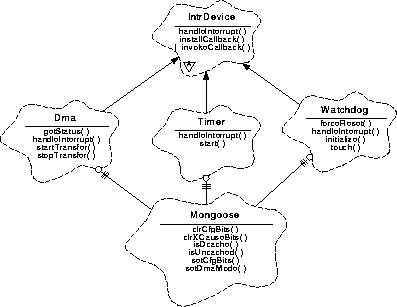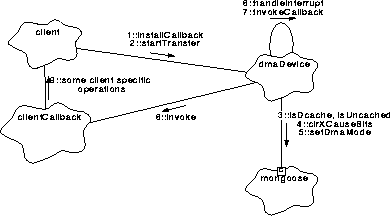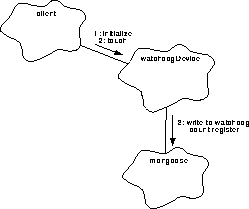 Table of Contents
Table of Contents
 Previous Chapter
Previous Chapter
ACIS
The Mongoose devices consists of a Direct-Memory-Access (DMA) Controller, General Purpose Timer, and a Watchdog Timer. The purpose of the Mongoose Device classes are to provide access to the each of these devices. Refer to TBD for a description of the hardware interfaces to these devices.
The Mongoose Dma, Timer and Watchdog classes provide the following features:
- Initiate DMA Transfers
- Stop DMA Transfers
- Handle DMA interrupts and forward control to an installed callback object
- Manage the General Purpose Timer
- Prevent hardware resets by setting Watchdog Timer count
- Force a hardware reset using the Watchdog Timer
The Mongoose DMA, Timer and Watchdog devices are interruptible, and therefore are all a subclass of IntrDevice (see Section 6.0 ). Each of these classes use the Mongoose class to obtain access to the Mongoose's Command/Status Interface (CSI) registers, and the IntrGuard class (not shown) to prevent interrupts during certain sections of code. Figure 25 illustrates the relationships used by the Dma, Timer and Watchdog classes.
FIGURE 25. Mongoose Dma, Timer and Watchdog Class Relationships

Dma - This class represents the Mongoose DMA device. It provides functions which start and stop DMA transfers (startTransfer, stopTransfer), return the status of the controller (getStatus), and handle interrupts (handleInterrupt). In addition to theses functions, it inherits the ability to install and invoke interrupt callback instances from IntrDevice.
Timer- This class represents the Mongoose General-Purpose Timer device. It provides functions which start the timer, specifying the interrupt period (start), and handle interrupts (handleInterrupt). In addition to theses functions, it inherits the ability to install and invoke interrupt callback instances from IntrDevice.
Watchdog- This class represents the Mongoose Watchdog Timer device. It provides functions to configure the watchdog time-out period (initialize), sets the down-counter to the time-out value (touch), and use the timer to force a system (forceReset). In order to support debugging when the reset logic is not enabled in the hardware, it also provides a function to handle interrupts (handleInterrupt) and inherits the ability to install and invoke interrupt callback instances from IntrDevice.
IntrDevice - This is an abstract class which defines the common interface to all types of interruptible devices. It is used by the Interrupt Controller (not shown) to dispatch control to interruptible devices, and by client code to install callback functions. Child classes of IntrDevice, including Dma, may use their parent's protected method, invokeCallback() to invoke the installed callback instance (see Section 6.0 ).
Mongoose - This class represents the lowest level hardware access to the features provided by the R3000 core processor and the Mongoose Microcontroller. The Dma, Timer and Watchdog classes use the Mongoose class to obtain access to the Mongoose's DMA, Timer, and Watchdog Count, Timer Count registers, the Mongoose Control Register (via setDmaMode, setCfgBits, and clrCfgBits), and the interrupt cause register (clrXCauseBits). The Dma class also uses the Mongoose class to test addresses for legal Mongoose DMA transfers (isDcache, isUncached).
The "Mongoose ASIC Microcontroller Programming Guide, Section: D-side Interface Block, DMA Channel" describes the interface to the DMA controller and lists the kinds of transfers supported by the Mongoose's DMA Controller. These transfer types are:
- Transfers from one uncached addressable region to another uncached region
- Transfers from an uncached address region into the data cache
- Transfers from the data cache into an uncached address region
All DMA transfers use 32-bit word reads and writes. When used with a 16-bit memory-mapped device (such as the Command FIFO), the most significant 16-bits of each copied DMA word will contain unspecified values.
The following diagram is used to illustrate the overall process involved in DMA transfers. Section 7.5.1 and Section 7.5.3 describe the scenarios illustrated by this diagram.
FIGURE 26. DMA Transfers and Interrupt Handling

The primary purpose of the DMA controller is to transfer information from one section of memory or device to another. Only one transfer is performed at a time, and it is up to the users of the Dma class to arbitrate (using getStatus) among themselves for access to the controller.
- During system initialization, the user of the Dma class constructs a subclass of DevCallback (not shown) and passes it to the Dma's installCallback() function (inherited from IntrDevice).
- When the client wishes to perform a transfer, it invokes the Dma's startTransfer() function.
- startTransfer() then determines the type of transfer by inspecting the source and destination addresses, using the Mongoose's isDcache() and isUncached() determine if an address is located within data cache or external memory, respectively.
- Once the type of transfer is determined, startTransfer() uses the Mongoose function clrXCauseBits() to clear any outstanding DMA interrupts.
- It then uses the Mongoose "regs" structure (not shown) to program the source, destination and transfer length registers, and sets the transfer into motion using setDmaMode(). Once the transfer completes, a DMA interrupt will be generated and the interrupt controller invokes the Dma's handleInterrupt() function. The interrupt handling actions are described below in Section 7.5.3
This use is not illustrated in Figure 26.
To abort a DMA transfer in progress, the user of the Dma invokes the stopTransfer() function. This function then uses the Mongoose functions setDmaMode and clrXCauseBits to stop the transfer, and clear any pending DMA interrupt.
Refer to Figure 26, "DMA Transfers and Interrupt Handling," on page 199 for an illustration of the scenario described in this section.
Whenever a DMA interrupt occurs, the Interrupt Controller (not shown) determines the cause of the interrupt, masks off any lower priority interrupt causes and re-enables interrupts. It then dispatches control to the Dma class's handleInterrupt(). The following describes the actions taken by the Dma class in response to an interrupt.
- Once the DMA transfer completes, the interrupt controller invokes the Dma's handleInterrupt() function. handleInterrupt() then clears the interrupt cause latch using the Mongoose's clrXCauseBits() function, as in step 4 (see Section 7.5.1 ).
- handleInterrupt() then invokes IntrDevice::invokeCallback() (inherited by Dma from IntrDevice) to test for and invoke the installed callback instance.
- IntrDevice::invokeCallback() then calls the installed callback instance's invoke() function.
- The callback's invoke() function then performs client specific operations needed to deal with the end of the DMA transfer.
Figure 27 illustrates the management of the Mongoose's General Purpose Timer.
FIGURE 27. Timer management

- A client object installs a callback instance, callback, to be invoked during interrupt processing, using timerDevice.installCallback().
- The client starts the timer, specifying the interrupt period to be generated, using timerDevice.start().
- timerDevice.start() saves the passed count into an instance variable, disables the timer enable bit, using mongoose.clrCfgBits(), clears any pending timer interrupt using mongoose.clrXCauseBits(), writes the passed count into the timer count register (not shown), and enables the timer using mongoose.setCfgBits().
- When the timer's count reaches zero, it generates an interrupt. The interrupt controller object, intrController, determines the cause, and tells the device object to handle the interrupt, using timerDevice.handleInterrupt().
- handleInterrupt() re-loads the timer's count register and clears the interrupt using mongoose.clrXCauseBits().
- handleInterrupt() then invokes the callback instance, using callback.invoke(). The process repeats from Step 4 until the instrument is reset.
Figure 28 illustrates how a client configures and uses the Watchdog Timer. Since the normal operating environment resets the processor rather than cause watchdog interrupts, the diagram and subsequent description omit interrupt handling.
FIGURE 28. Watchdog Timer Management

- The client sets the watchdog time-out period using watchdogDevice.initialize().
- At a rate within the time-out period, the client prevents a watchdog reset from occurring by periodically calling watchdogDevice.touch().
- watchdogDevice.touch() writes the configured time-out value into the watchdog down-count register. If the client does not call touch() within the configured period, the down-count register will reach zero, and the hardware will cause a reset on the Back End Processor.
To force a hardware reset, the client calls watchdogDevice.forceReset(). forceReset() stores a 1 into the Mongoose's watchdog down-count register and attempts to enter an infinite loop. The down-counter decrements once and reaches zero, causing the hardware to generate a physical reset of the Back End Processor.
Documentation:
- This class represents the Mongoose on-chip Direct-Memory-Access (DMA) controller.
Export Control:
- Public
Cardinality:
- 1
Hierarchy:
Superclasses:
IntrDevice
Implementation Uses:
Mongoose
Public Interface:
Operations:
getStatus()
handleInterrupt()
startTransfer()
stopTransfer()
Protected Interface:
Has-A Relationships:
- DmaState dmaState: This variable contains the current state of the DMA device.
Concurrency:
- Guarded
Public member of:
- Dma
Return Class:
- DmaState
Documentation:
- This function returns the current transfer status of the Dma class. The return values are as follows:
DMASTATE_IDLE- No transfer in progress
DMASTATE_BUSY - A DMA transfer is underway
Concurrency:
- Guarded
Public member of:
- Dma
Return Class:
- void
Documentation:
- This function handles DMA interrupts, by clearing the DMA extended cause bit, and by invoking the installed interrupt callback instance.
Postconditions:
- If no new transfers are started by the callback instance, subsequent calls to getStatus() will return DMASTATE_IDLE. If the callback starts a new transfer, getStatus() will return DMASTATE_BUSY if the new transfer is still underway.
Concurrency:
- Synchronous
Public member of:
- Dma
Return Class:
- Boolean
Arguments:
const unsigned* srcAddress
volatile unsigned* dstAddress
unsigned xfrLength
Documentation:
This function initiates a DMA transfer, copying xfrLength words from srcAddress to dstAddress. If the arguments are valid, this function starts the transfer and returns BoolTrue. If the arguments are invalid, it returns BoolFalse.
Preconditions:
A transfer must not already be in progress.
- srcAddress
and dstAddress and xfrLength must be set to support one of the following transfer types:
data cache to external memory/device transfer
external memory/device to data cache transfer
external memory/device to external memory/device.
Semantics:
- Test transfer type, clear DMA mode and DMA interrupt, program source, destination and length and set the DMA mode to kick off the transfer
Postconditions:
- A transfer will be underway (or already completed if very short). A DMA interrupt may occur after this function returns and the buffer pointed to by dstAddress will be changing under one's feet. Calls to getStatus() may return either DMASTATE_IDLE if the transfer has already completed, or DMASTATE_BUSY if the transfer is still underway.
Concurrency:
- Guarded
Public member of:
- Dma
Return Class:
- void
Documentation:
- This function stops a DMA transfer in-progress and clears any pending DMA interrupts.
Semantics:
- Set the DMA mode to stop a transfer and clear the DMA Extended Cause bit.
Postconditions:
- Any transfers will be aborted. Calls to getStatus() will return DMASTATE_IDLE.
Concurrency:
- Guarded
Export Control:
- Public
Cardinality:
- 1
Hierarchy:
Superclasses:
IntrDevice
Implementation Uses:
Mongoose
Public Interface:
Operations:
handleInterrupt()
start()
Protected Interface:
Has-A Relationships:
- unsigned timeout: This is the value to store into the timer's counter upon each interrupt.
Concurrency:
- Guarded
Persistence:
- Persistent
Public member of:
- Timer
Return Class:
- void
Documentation:
- This function overloads the IntrDevice handleInterrupt function. For the Timer device, this function clears the interrupt cause, re-loads the timer's count and invokes the installed callback.
Concurrency:
- Guarded
Public member of:
- Timer
Return Class:
- void
Arguments:
unsigned clockTicks
Documentation:
This starts the Mongoose Timer. clockTicks specifies the number of processor clocks per timeout of the timer.
Concurrency:
- Guarded
Export Control:
- Public
Cardinality:
- 1
Hierarchy:
Superclasses:
IntrDevice
Implementation Uses:
Mongoose
Public Interface:
Has-A Relationships:
- unsigned count: This is the time-out count to use. Each call to touch() causes this count to be loaded into the timer's counter.
Operations:
forceReset()
handleInterrupt()
initialize()
touch()
Concurrency:
- Guarded
Persistence:
- Persistent
Public member of:
- Watchdog
Return Class:
- void
Documentation:
- This function causes the watchdog timer to reset the instrument hardware by writing a 1 into the timer's down-count register and entering an infinite loop. When the down-counter reaches 0, the hardware will reset the Back End Processor.
Concurrency:
- Guarded
Public member of:
- Watchdog
Return Class:
- void
Documentation:
- This function overloads the IntrDevice handleInterrupt function, and is used when debugging the instrument software.This function clears the interrupt cause, and invokes the installed callback.
Concurrency:
- Guarded
Public member of:
- Watchdog
Return Class:
- void
Arguments:
unsigned timeout
Documentation:
This function sets the time-out period of the watchdog timer. timeout is the maximum number of clock cycles that can occur between each call to touch().
Concurrency:
- Guarded
Public member of:
- Watchdog
Return Class:
- void
Documentation:
- This function copies the configured count value into the mongoose's watchdog down-count register. This function must be called at least once every count clock cycles, or the timer will expire and reset the processor (or, if debugging, cause a watchdog interrupt).
Concurrency:
- Synchronous
 Table of Contents
Table of Contents
 Next Chapter
Next Chapter
 Table of Contents
Table of Contents
 Previous Chapter
Previous Chapter
 Table of Contents
Table of Contents
 Previous Chapter
Previous Chapter